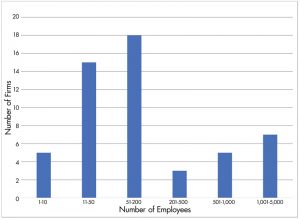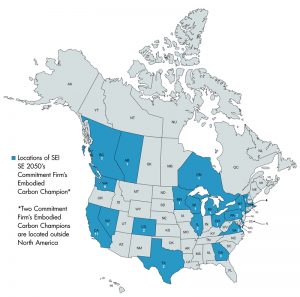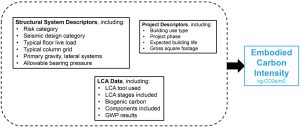One year since the launch of the Structural Engineering Institute’s (SEI) Structural Engineers (SE) 2050 Commitment Program, 53 structural engineering firms have committed to embodied carbon neutrality by 2050. The Program’s overarching goal is to provide an accessible sustainability program for structural engineers that includes a commitment of active engagement in reducing the embodied carbon on projects and information sharing. The driver of these objectives is the collective objective of achieving net-zero carbon structures by 2050.
History
In 2016, the Carbon Leadership Forum (CLF) at the University of Washington created a working group to develop a data-driven commitment program for structural engineering firms to measure and work towards net-zero embodied carbon buildings. The CLF proposed their idea and the Structural Engineers 2050 Challenge framework to the American Society of Civil Engineers (ASCE) SEI Sustainability Committee.
The ASCE SEI Sustainability Committee further developed the goals, requirements, and resources to make an official commitment program feasible and realistic to practicing structural engineers. After years of hard work by the ASCE SEI Sustainability Committee volunteers, the SEI SE 2050 Commitment Program was endorsed by SEI in late 2019 and launched to the public at Greenbuild 2020 as an SEI Program. The Program is run by volunteer members of the SE 2050 Subcommittee of the SEI Sustainability Committee.

Committed Firms Support the Program
Since the Program’s launch in October 2020, 53 firms have officially signed on to the SEI SE 2050 Commitment Program. From data submitted by committed firms, approximately 72 percent have no more than 200 employees, with 20 committed firms having 50 or fewer employees. The distribution of firm sizes illustrates that embodied carbon is a critical issue to firms of all sizes in the structural engineering community. The Chart displays the distribution of firm sizes committed to the SEI SE 2050 Commitment Program as of the beginning of August 2021.
Championing Carbon Reduction within the Firm
When a firm commits to the Program, they assign an employee to serve as an embodied carbon reduction champion and act as the main point of contact for the Committee and Program. Additional responsibilities of the champion include educating and advocating for embodied carbon reductions and ensuring the firm meets the yearly requirements of the Program. The state with the largest number of embodied carbon reduction champions is California, with eleven. Washington state follows with six and Massachusetts with four. In addition, two champions are located outside of North America. Figure 1 highlights in blue where the embodied carbon reduction champions are located in North America and the number per state as of the beginning of August 2021.

A Roadmap to Reduce Carbon
Each committed firm must develop and submit an Embodied Carbon Action Plan (ECAP). The purpose of the ECAP is to articulate how a firm educates its staff, reports, documents reduction strategies, and advocates within the industry for and on embodied carbon. For companies wishing to simplify their ECAP submission, the SEI SE 2050 website contains an ECAP Google Form submission option allowing firms to streamline the creation of their ECAP. All committed firms’ ECAPs are publicly available and updated yearly. Of the 53 firms committed to the Program, 13 have submitted their first-ever ECAP as of the beginning of August 2021.
The SEI SE 2050 website lists the committed companies, the name of their internal embodied carbon reduction champion, the year the company committed to the Program, and a link to their ECAP. The SE 2050 Committee continuously updates this table as new firms commit and ECAPs are submitted.
Submitting Data to the Program
In addition to developing an ECAP, committed firms measure the embodied carbon of multiple projects’ structural systems and submit their findings to the SE 2050 database. Firms commit to at least two project submissions per North American structural office but need not exceed five total projects per year. After months of development and testing, the database was officially launched on the SEI SE 2050 website in September 2021. A committed firm’s embodied carbon reduction champion can access the database from the website, add company users, and begin submitting embodied carbon data. The SE 2050 Committee has published a user guide to aid users in navigating and reporting their projects to the database.

The information collected by the database includes project descriptors, structural system descriptors, and embodied carbon data. Figure 2 illustrates the different parameters submitted for each project to the SEI SE 2050 database. After a sufficient amount of data is collected, embodied carbon benchmarking for different building types can begin to be formed.
Resources for the Structural Engineer
To help committed firms, the SE 2050 Subcommittee continues to add and update embodied carbon guidance on its website. Highlights of some of the currently released and upcoming resources include:
- A guide to embodied carbon-related credits in green rating systems (USGBC LEED, Green Globes, Envision, etc.). This resource helps structural engineers learn and advocate for embodied carbon measuring and reduction credits depending on the green rating system a project is pursuing.
- Embodied Carbon Intensity Diagrams showing the range of embodied carbon intensities associated with common structural floor systems. Updates will add more framing systems and bay layouts to those already available. Some of the upcoming embodied carbon intensity floor diagrams to be released include a reinforced concrete flat plate, concrete pan joist, light-framed wood, and a hybrid mass timber/steel floor scheme.
- Embodied Carbon Estimator (ECOM) for structural materials. Updates to the existing ECOM tool could include visual updates, report generation, and a user option to input custom global warming potential data from a product-specific Environmental Product Declaration (EPD). The Committee is also developing an ECOM guidance document and examples.
- Case Studies. A list of project case studies discussing how embodied carbon was considered during design and construction has been added to the SE 2050 website for users looking for guidance or ideas on their projects.
- Project specifications guidance. This document will provide guidance to structural engineers on incorporating different embodied carbon reduction strategies into project specifications for multiple types of structural materials.
In Closing
Clients, government officials, and future engineers are interested and actively discussing embodied carbon. The SEI SE 2050 website and team are dedicated to helping structural engineers learn about and reduce embodied carbon.
The structural engineering community has responded enthusiastically to the SEI SE 2050 Commitment Program and, within the first year, the Program has picked up significant momentum. The Program provides engineers a platform to play an active role in embodied carbon measurements and reduction strategies. The SE 2050 Committee is continually working to provide additional embodied carbon resources and Program improvements to meet this demand and enthusiasm to continue the impetus for the next year and beyond.
If your firm is interested in learning more or joining the movement towards net-zero embodied carbon by 2050, please visit the SEI SE 2050 Program’s website: se2050.org to learn more.■
